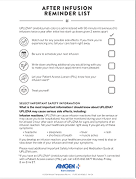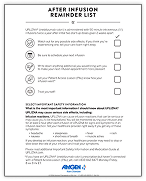

Post-Infusion Checklist
Download and use this checklist after each infusion.
No matter where you are in your treatment experience, Amgen By Your Side is committed to helping you. Your Patient Access Liaison (PAL) is a dedicated support partner who helps investigate, explain, and educate on the steps of your treatment experience.

Stay motivated between your infusions to stay on track with your treatment as prescribed by your doctor/healthcare provider.
Your PAL can answer questions you have and help you prepare for your next infusions. Guidance from your doctor can also help you to know more about managing your condition. Learn how to enroll.
BKEMV is not for use in treating people with Shiga toxin E. coli related hemolytic uremic syndrome (STEC-HUS).
It is not known if BKEMV is safe and effective in children with PNH or gMG.
BKEMV is a medicine that affects your immune system and may lower the ability of your immune system to fight infections.
Your healthcare provider will give you a Patient Safety Card about the risk of serious meningococcal infection. Carry it with you at all times during treatment and for 3 months after your last dose of BKEMV. Your risk of meningococcal infection may continue for several weeks after your last dose of BKEMV. It is important to show this card to any healthcare provider who treats you. This will help them diagnose and treat you quickly.
BKEMV is only available through a program called the BKEMV Risk Evaluation and Mitigation Strategy (REMS). Before you can receive BKEMV, your healthcare provider must:
BKEMV may also increase the risk of other types of serious infections, including Streptococcus pneumoniae, Haemophilus influenzae, and Neisseria gonorrhoeae.
Who should not receive BKEMV?
Do not receive BKEMV if you have a serious meningococcal infection when you are starting BKEMV.
Before you receive BKEMV, tell your healthcare provider about all of your medical conditions, including if you: have an infection or fever, are pregnant or plan to become pregnant, and are breastfeeding or plan to breastfeed. It is not known if BKEMV will harm your unborn baby or if it passes into your breast milk.
Tell your healthcare provider about all the vaccines you receive and medicines you take, including prescription and over-the-counter medicines, vitamins, and herbal supplements which could affect your treatment. BKEMV and other medicines can affect each other causing side effects. Know the medications you take and the vaccines you receive. Keep a list of them to show your healthcare provider and pharmacist when you get a new medicine.
What are the possible side effects of BKEMV?
BKEMV can cause serious side effects, including serious infusion-related reactions. Tell your healthcare provider or nurse right away if you get any of these symptoms during your BKEMV infusion: headache, back pain, diarrhea, upper respiratory infection, urinary tract infections, fever, pain in your abdomen, pain or swelling of your nose or throat, common cold, cough, nausea, vomiting, chest pain, high blood pressure, low red blood cell count, trouble breathing or shortness of breath, swelling of your face, tongue, or throat, swelling of legs or feet, muscle and joint pain, and feeling faint or passing out. If you have an infusion-related reaction to BKEMV, your healthcare provider may need to infuse BKEMV more slowly, or stop BKEMV.
Tell your healthcare provider about any side effect that bothers you or that does not go away.
These are not all the possible side effects of BKEMV. For more information, ask your healthcare provider or pharmacist. Call your healthcare provider for medical advice about side effects. You may report side effects to FDA at 1-800-FDA-1088.
Please see full Prescribing Information and Medication Guide for BKEMV.
BKEMV is not for use in treating people with Shiga toxin E. coli related hemolytic uremic syndrome (STEC-HUS).
It is not known if BKEMV is safe and effective in children with PNH or gMG.
BKEMV is a medicine that affects your immune system and may lower the ability of your immune system to fight infections.
Your healthcare provider will give you a Patient Safety Card about the risk of serious meningococcal infection. Carry it with you at all times during treatment and for 3 months after your last dose of BKEMV. Your risk of meningococcal infection may continue for several weeks after your last dose of BKEMV. It is important to show this card to any healthcare provider who treats you. This will help them diagnose and treat you quickly.
BKEMV is only available through a program called the BKEMV Risk Evaluation and Mitigation Strategy (REMS). Before you can receive BKEMV, your healthcare provider must:
BKEMV may also increase the risk of other types of serious infections, including Streptococcus pneumoniae, Haemophilus influenzae, and Neisseria gonorrhoeae.
Who should not receive BKEMV?
Do not receive BKEMV if you have a serious meningococcal infection when you are starting BKEMV.
Before you receive BKEMV, tell your healthcare provider about all of your medical conditions, including if you: have an infection or fever, are pregnant or plan to become pregnant, and are breastfeeding or plan to breastfeed. It is not known if BKEMV will harm your unborn baby or if it passes into your breast milk.
Tell your healthcare provider about all the vaccines you receive and medicines you take, including prescription and over-the-counter medicines, vitamins, and herbal supplements which could affect your treatment. BKEMV and other medicines can affect each other causing side effects. Know the medications you take and the vaccines you receive. Keep a list of them to show your healthcare provider and pharmacist when you get a new medicine.
What are the possible side effects of BKEMV?
BKEMV can cause serious side effects, including serious infusion-related reactions. Tell your healthcare provider or nurse right away if you get any of these symptoms during your BKEMV infusion: headache, back pain, diarrhea, upper respiratory infection, urinary tract infections, fever, pain in your abdomen, pain or swelling of your nose or throat, common cold, cough, nausea, vomiting, chest pain, high blood pressure, low red blood cell count, trouble breathing or shortness of breath, swelling of your face, tongue, or throat, swelling of legs or feet, muscle and joint pain, and feeling faint or passing out. If you have an infusion-related reaction to BKEMV, your healthcare provider may need to infuse BKEMV more slowly, or stop BKEMV.
Tell your healthcare provider about any side effect that bothers you or that does not go away.
These are not all the possible side effects of BKEMV. For more information, ask your healthcare provider or pharmacist. Call your healthcare provider for medical advice about side effects. You may report side effects to FDA at 1-800-FDA-1088.
Please see full Prescribing Information and Medication Guide for BKEMV.